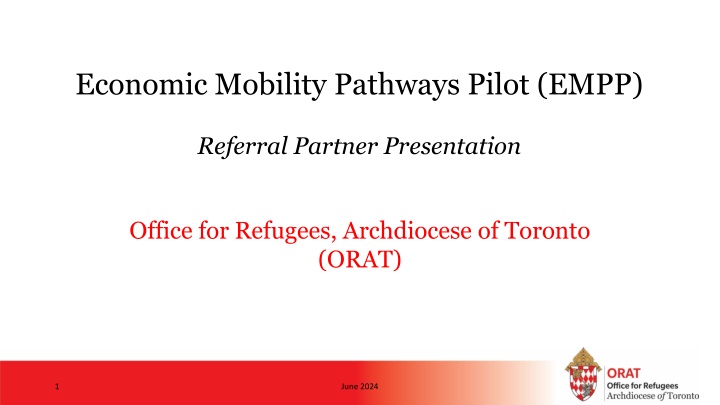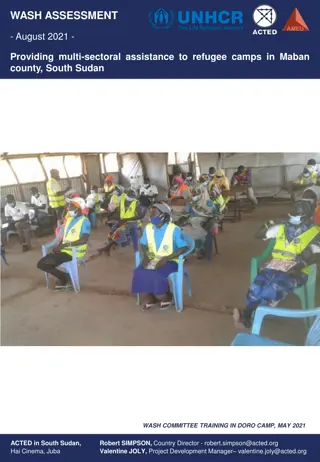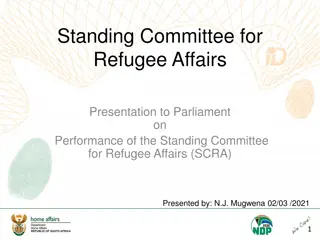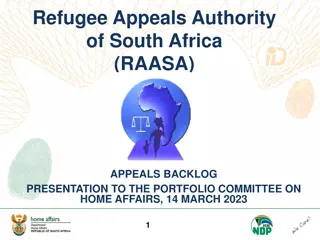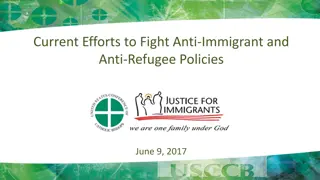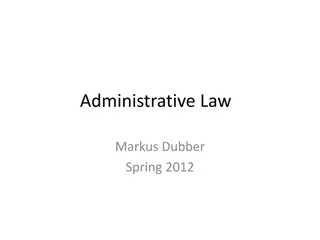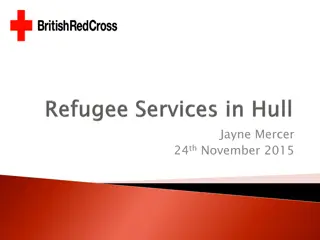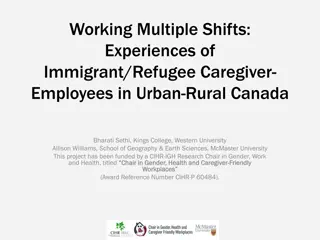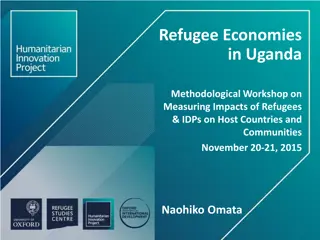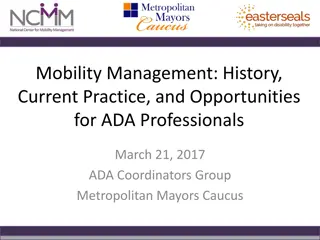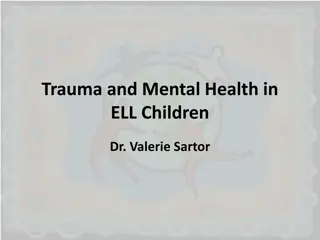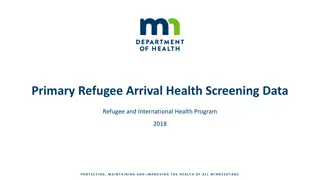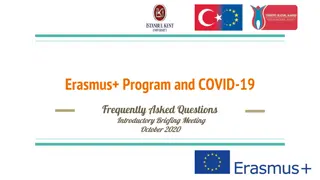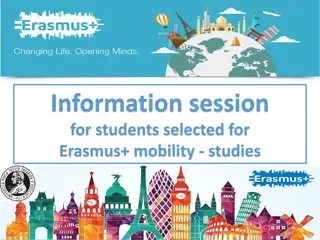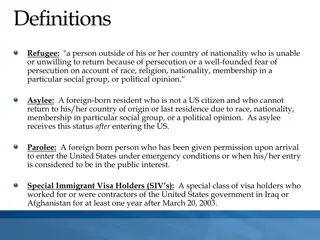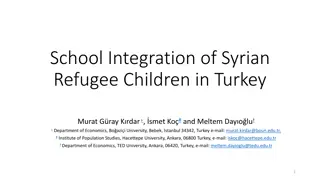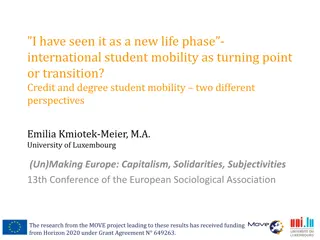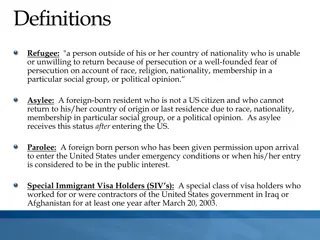Economic Mobility Pathways Pilot: Refugee Program Overview
The Economic Mobility Pathways Pilot (EMPP) is a program that merges refugee resettlement with economic immigration to help skilled refugees with language proficiency resettle in Canada. Trusted Partners and Referral Partners play vital roles in connecting employers with eligible refugees, facilitating the immigration process, and supporting settlement. Learn about the roles, responsibilities, and steps involved in EMPP through this comprehensive presentation.
Download Presentation

Please find below an Image/Link to download the presentation.
The content on the website is provided AS IS for your information and personal use only. It may not be sold, licensed, or shared on other websites without obtaining consent from the author.If you encounter any issues during the download, it is possible that the publisher has removed the file from their server.
You are allowed to download the files provided on this website for personal or commercial use, subject to the condition that they are used lawfully. All files are the property of their respective owners.
The content on the website is provided AS IS for your information and personal use only. It may not be sold, licensed, or shared on other websites without obtaining consent from the author.
E N D
Presentation Transcript
Economic Mobility Pathways Pilot (EMPP) Referral Partner Presentation Office for Refugees, Archdiocese of Toronto (ORAT) 1 June 2024
Meeting Agenda About EMPP Trusted Partner s Role Referral Partner Responsibilities Eligibility Criteria Refugee Definition Durable Solution EMPP Process Steps ORAT Responsibilities as a Trusted Partner Appendix FAQs 2
About EMPP The Economic Mobility Pathways Pilot (EMPP) is a program that combines refugee resettlement and economic immigration. It helps refugees who have in-demand skills, and a certain level of English language comprehension immigrate to Canada. EMPP gives employers access to a new pool of qualified candidates to fill job openings. EMPP relies on Trusted Partners to connect employers with eligible refugees. 3
Trusted Partners play a key coordinate role, relying on Referral Partners to select eligible Refugees Referral Partner Referral Partner Role Trusted Partner Role Build Program Awareness Identifies Employer Demand Identifies Eligible Refugees Engages & Educates Referral Partners Conducts Preliminary Eligibility Assessment Work, Education, English Language, and Program Fit Trusted Partner Assessment of Refugee s Eligibility IRCC Refugees Connects Employer with Refugee Assists with English Language Testing Completes & Submits Application to IRCC Assists with CV Creation Employer Program Oversight 4
ORATs Responsibilities as a Trusted Partner Identify Employer Needs Select Eligible Candidates (CV): Refugee & Durable Solution In-Demand Skill(s) English Language Assessment Completion / Submission of Immigration Forms Newcomer Orientation Facilitate Arrival & Settlement Support 5
Referral Partner Responsibilities Build Program Awareness Identify / Select Eligible Refugees Confirm In-Demand Employment Skills (NOC) Preliminary Assessment of English Language Skills Preliminary Assessment of Refugee Claim & Durable Solution Assist with English Language Testing Assist with Job Curriculum Vitae (CV) Creation 6
Program Eligibility Criteria Refugee Claim Convention Refugee and/or Country of Asylum Class No Durable Solution Program Fit Working Age Able Bodied Hard Working Good Character Employment Experience 1,560 hours of paid work experience English Language A Teer 4 or 5 (NOC) job requires a minimum of level 4 of the Canadian Language Benchmark (CLB). Test results within 2 years of application date. Work/Education Requirements Teer 4 (NOC): a high school diploma, or several weeks of on-the-job training Teer 5 (NOC): Occupations that usually need short-term work demonstration and no formal education 7
Refugee Definition & Classes Definition Classes Convention Refugee Abroad Class A refugeeis any person who: owing to well-founded fear of being persecuted for reasons of race, religion, nationality, membership of a particular social group or political opinion, is outside the country of his nationality and is unable or, owing to such fear, is unwilling to avail himself of the protection of that country; or who, not having a nationality and being outside the country of his former habitual residence as a result of such events, is unable or, owing to such fear, is unwilling to return to it . Are persons who are outside your home country, cannot return there due to a well-founded fear of persecution based on, race, religion, political opinion, nationality, or membership in a particular social group. Country of Asylum Class Are persons who are outside your home country, or the country where you normally live, and have been seriously affected by civil war or armed conflict or have been denied basic human rights on an ongoing basis. 8
Durable Solution: To be eligible Applicants must not have a durable solution The following are the 3 types of Durable Solutions: Voluntary Repatriation occurs when refugees voluntarily return to their country of nationality or habitual residence. Local Integration is a long-lasting solution to a refugee s situation. It is more than the granting of safe conditions of asylum. Local integration allows refugees to participate broadly in the host society (i.e., work, education, healthcare, etc) Resettlement in a Country other than Canada. This option is an offer of resettlement to a country (other than Canada) is, in most cases, a durable solution. 9
EMPP Process Steps Employer Interviews Candidates for Selection ORAT Completes & Submits Forms to IRCC ORAT Reviews Qualified Refugees Identify Needs Medicals & Travel Arrangements IRCC s Review Arrival & Settlement (Max: 6 months) (3 months) 10
Appendix 11
About ORAT The Office of Refugees (ORAT) is a department of the Roman Catholic Archdiocese of Toronto. ORAT administers the Archdiocese s Sponsorship Agreement by partnering with church communities who have been affected by the global refugee crisis to sponsor parishioner families to Canada. We offer a program for those outside the church as well. ORAT plans to work through these church communities to identify qualified refugees for this program. 12
FAQs: Refugee Work Experience & Language Capabilities: Selected candidates must have the relevant skills & experience in the field of work. They need to meet English language requirements. Status: Approved refugees, along with their immediate family* arrive in Canada as Permanent Residents. National Occupation Classification (NOC): NOC is used to identify the education, work experience and English language competency that is required by the refugees. * Immigration Canada defines a family as father, mother and dependent children under the age of 22 13
National Occupation Classification (NOC) Teers TEER Occupation types Examples TEER 0 Management occupations Advertising, marketing and public relations managers Financial managers TEER 1 Occupations that usually require a university degree Financial advisors Software engineers TEER 2 Occupations that usually require a college diploma apprenticeship training of 2 or more years, or supervisory occupations Computer network and web technicians Medical laboratory technologists TEER3 Occupations that usually require a college diploma apprenticeship training of less than 2 years, or more than 6 months of on-the-job training Bakers Dental assistants and dental laboratory assistants TEER 4 Occupations that usually require a high school diploma, or several weeks of on-the-job training Home child care providers. Home support workers, caregivers and related occupations. Tailors, dressmakers, Retail salespersons and visual merchandisers. Security guards & related security service occupations TEER 5 Occupations that usually need short-term work demonstration and no formal education Landscaping and grounds maintenance labourers. Light & heavy-duty cleaners. General labourers across a number of industries Delivery service drivers and door-to-door distributors Store shelf stockers, clerks and order fillers. Food counter attendants, kitchen helpers, servers Construction trades helpers and labourers. Other trades helpers and labourers 14
EMPP is divided into Regional & Federal Streams The Regional EMPP 1. Through one of following 3 selected economic programs. Atlantic Immigration Program Provincial Nominee Program Rural and Northern Immigration Program (RNIP) 2. To be eligible for one of the above programs, the TP must first apply to a province, territory or RNIP community (depending on which program is chosen) The Federal EMPP: The federal EMPP includes a Job Offer and No Job Offer stream. 1. No Job Offer Stream: Applicant applies directly to IRCC. 2. Applicants need to meet the work experience, education, and language requirements. 3. Job Offer Stream Requirements: Applicants must have a job offer that is; full time (at least 30 hours/week) and non-seasonal from a Canadian employer for a job listed in TEER Categories 0, 1, 2, 3, 4 or 5 of the National Occupation Classification 15
